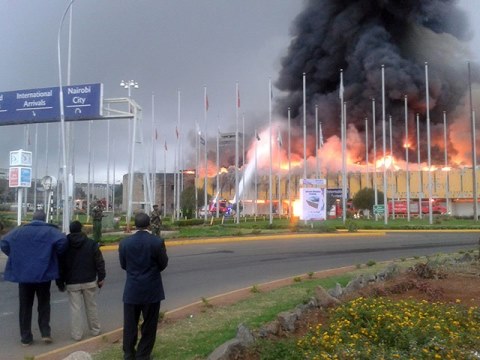
The Importance of Airport Design and Glazing Systems
As recent events in Kenya have shown, both fire and terrorist attacks are potent threats to be assessed and comprehensively guarded against. With regular rehearsals, it can be ensured that response teams can adequately deal with any emergency.
- By Jane Embury
- Oct 18, 2013
 Kenya has been in the news a lot lately, and not for the right reasons. On September 21, the Westgate shopping mall was attacked by Somali militants, and at least 67 people were killed in the massacre. And in August, a major fire at the Jomo Kenyatta International Airport in Nairobi brought more media attention to the region. Both of these incidents are shocking reminders that any building can become a place where people’s lives can be in danger, whether from a terrorist attack or as a result of a fire.
Kenya has been in the news a lot lately, and not for the right reasons. On September 21, the Westgate shopping mall was attacked by Somali militants, and at least 67 people were killed in the massacre. And in August, a major fire at the Jomo Kenyatta International Airport in Nairobi brought more media attention to the region. Both of these incidents are shocking reminders that any building can become a place where people’s lives can be in danger, whether from a terrorist attack or as a result of a fire.
That security threat is a real and common occurrence at airports, which can have a pivotal role in regional or national economies and, for the terrorists, significant news value. Therefore, airports have seen the greatest investment in security and building research. However, the threat is not confined to larger hub airports. The 2007 attack at Glasgow airport underlines how terrorism can be national or local, meticulously planned for maximum effect or simply opportunistic.
But it would be simplistic to consider airport security purely in terms of terrorist threats. Other threats exist, such as the aforementioned fire at Nairobi’s Jomo Kenyatta airport. The catastrophic fire, most likely started by faulty wiring, demonstrates how a major infrastructure asset can quickly become a national liability. The airport was built in an age before modern fire regulations and protective systems were available or required. As a result of the fire, the airport was extensively damaged and a vital transport gateway was closed off. Remarkably, there were no casualties.
The Nairobi fire is a stark reminder of the importance of identifying every conceivable threat, that strategies to deal with them are robustly examined, and emergency procedures routinely tested. Sadly, that wasn’t the case in Nairobi with its aged infrastructure, inadequate emergency equipment and poor response planning.
Countering those threats starts with a comprehensive assessment of the likely (or unlikely) risks an airport might face in terms of an accidental or deliberate interruption to its operations. Modern building safety is largely determined by taking a multi-disciplinary approach to assessing those hazards from power failure to cyber attack, from civil disorder to fire and explosive detonation.
For an airport, other factors might have to be considered such as the kind of threat specific to that country or region, to the airlines that make use of the facility. While terrorism is often a blunt instrument involving random carnage, it can also be targeted more specifically.
There are a number of assessment methodologies to understand the potential threats, identify the assets to be protected, and how best to mitigate against those risks. That assessment then guides the design team in determining acceptable risks and the cost-effectiveness of the measures proposed, both airside and landside.
The UK has been at the forefront of airport safety, largely because of the historical threats posed by Irish terrorists which included mortar bombs being fired onto the runway at London Heathrow in 1994. The bombs failed to detonate but underlined how airport security is an issue that has to be considered outside, not just inside, the airport’s perimeter.
That is the airport designer’s conundrum: how to build a facility able to safely handle large numbers of people, while making their experience as hassle-free as possible. Official guidance now covers all of an airport’s critical functions from security checks on passengers to aircraft hold baggage, from the location of car parks to the glazed elements in the building’s design. The guidance also includes the design of areas immediately outside terminal buildings to create an exclusion zone for unauthorized vehicles.
In the United States, the Office of Airport Safety and Standards has primary responsibility for all airport program matters related to standards for airport design, construction, maintenance, operations and safety.
Stand-off distance is an important consideration. A bomb detonating at seven meters from the terminal façade will, depending on the size of the bomb and type of explosive, generate blast pressure of up to one ton per square foot. At 30 meters, blast pressure falls to one-tenth of a ton per square foot – within building regulation parameters on structural integrity.
 Modern building design, in airports and elsewhere, now makes extensive use of glass. It brings in ambient light and creates a more pleasant interior environment. The extensive use of glass has come about as a result of investment in innovation, both to develop new laminated glass types and framing systems able to withstand blast pressure, as well as to accurately evaluate those systems using a variety of assessment and computational tools.
Modern building design, in airports and elsewhere, now makes extensive use of glass. It brings in ambient light and creates a more pleasant interior environment. The extensive use of glass has come about as a result of investment in innovation, both to develop new laminated glass types and framing systems able to withstand blast pressure, as well as to accurately evaluate those systems using a variety of assessment and computational tools.
That’s why it’s important to choose a company that is closely involved in that process of development such as designing and testing exterior and interior glazing systems and doors that are able to withstand explosive blast pressures and, of course, to guard against fire, smoke and toxic gases for up to 120 minutes.
Some companies conduct live bomb testing to further ensure the capabilities of their products. It’s also good practice to specify the glass and framing as one unit. In a real fire or terrorist situation, the glass will only be as protective as its frame, and vice versa.
As recent events in Kenya have shown, both fire and terrorist attacks are potent threats to be assessed and comprehensively guarded against. With regular rehearsals, it can be ensured that response teams can deal with any emergency adequately. That multi-dimensional approach extends across the built environment, developing next-generation products and systems to guarantee new levels of fire and terrorist protection. The specialist glass and glazing industry remains at the forefront of that innovative research process.